The iPhone 7 and iPhone 7 Plus Review: Iterating on a Flagship
by Joshua Ho & Brandon Chester on October 10, 2016 8:00 AM EST- Posted in
- Smartphones
- Apple
- Mobile
- iOS
- iOS 10
- iPhone 7
- iPhone 7 Plus
GPU Performance
Section by Brandon Chester
Now that the general system and CPU performance of A10 Fusion has been characterized, we can move on to more focused benchmarks for the GPU and the storage subsystem. Apple's keynote for the iPhone 7 actually disclosed that the GPU in A10 Fusion is a six core part. The last time I recall Apple mentioning specifics about their GPU was with the launch of the iPad 3, where the GPU was advertised as a quad core implementation that turned out to be SGX543MP4.
The use of a six core GPU is interesting because there's not much choice for Apple given that A9 also used the six core PowerVR GT7600. It really boils down to three possibilities. The first is that Apple has actually continued using the exact same GT7600 microarchitecture as on the A9, albeit with an improved layout on the die. The second is that Apple has moved to PowerVR GT7600 Plus, which brings some improvements to integer compute performance, and memory bandwidth optimizations. And the third is the wildcard option - that Apple has put to use its significant GPU engineering resources on a more customized design; something that's still using the PowerVR architecture, but more custom than ever before. This is a longer discussion to have in our full deep dive, but Ryan's of the opinion that this is somewhere between options two and three, that Apple has done some significant work to produce a highly optimized version of the PowerVR GT7600 Plus
In any case, as Apple isn't using a radically different GPU architecture, most of Apple's stated 50% increase in GPU power comes from increasing the clock speeds, with optimizations such as memory and caching picking up the rest. This is interesting because Apple also advertises that A10 Fusion's GPU uses only two thirds the power of A9, which would indicate a lot of work done by Apple to optimize for power usage.


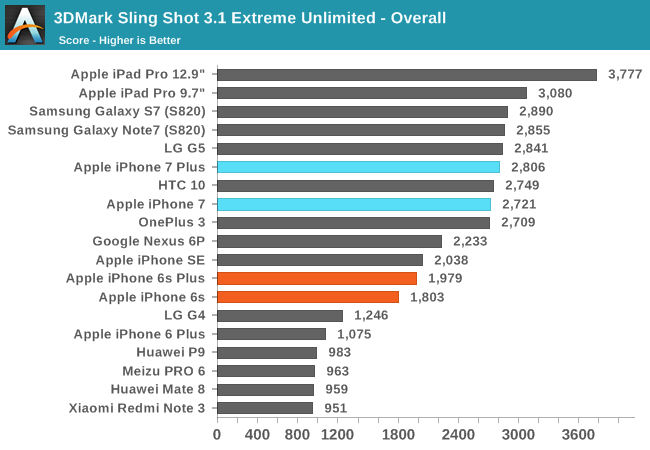
3DMark Sling Shot is broken down into a few different tests, and at the end the results of graphics tests and physics tests produce separate scores which are then used to generate an overall score.
In the graphics test the results are in line with Apple's stated GPU performance improvement of 50%. The physics score, which is really a CPU test, only improves by 30-35%, which has a direct correlation to the increase in peak clock speed from 1.8GHz on A9 to 2.3GHz in A10 fusion.
Like Ice Storm, the physics test is still basically a chart of devices ranked by cores multiplied by max frequency, and you can see that the iPhones have improved very little over the years, with the improvements tracking closely to Apple's increases in CPU clock speed. This comes down to the test being designed in such a way that there's little instruction level parallelism to exploit due to memory dependencies, which puts Apple's wide dual core CPU at a disadvantage. While it is certainly a valid test situation, it's not really reflective of actual 3D game performance because you would generally not write a game in such a way that it cannot exploit the performance of its target hardware.
Even with the smaller improvement in the physics tests, the overall score for the iPhone 7 is still roughly 50% higher than the Apple A9 devices like the iPhone 6s and SE.
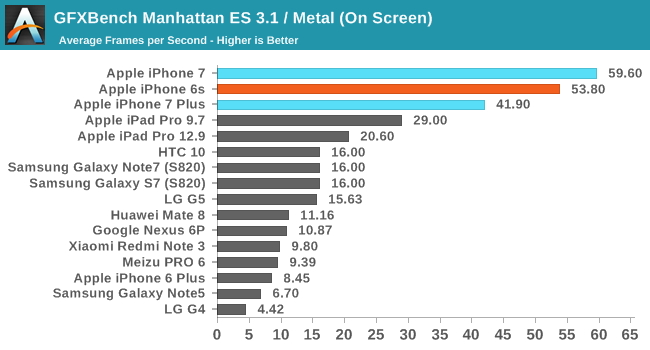
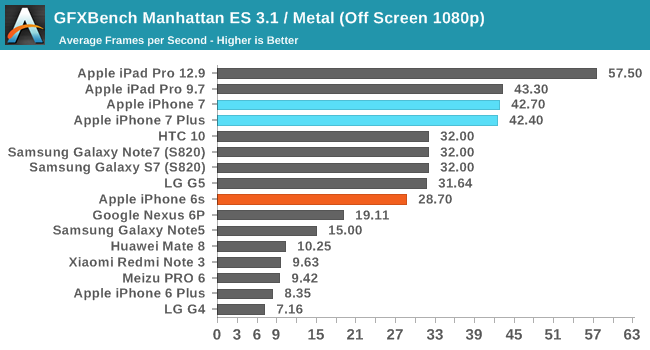
We originally migrated away from Manhattan ES 3.0 to Manhattan ES 3.1 / Metal to push back on devices hitting VSync in the on screen tests. Unfortunately it didn't work for long. With the iPhone 7's increase in GPU performance not being accompanied by an increase in display resolution, the on screen result in GFXBench Manhattan is higher than any other device, and is essentially at the display's refresh limit. The iPhone 7 Plus isn't able to hit Vsync due to its higher resolution, but the on screen result of roughly 42fps is nothing to scoff at either considering the visual complexity of the test.
While on screen performance is helpful from the perspective of someone who wants to see how the phone will actually perform when running a game at its native resolution, to compare directly between devices you need to standardize the rendering resolution. As its name implies, GFXBench's off screen test simply renders all the frames at 1080p in an off screen buffer. In this test the iPhone 7 and 7 Plus both run slightly below 43fps, which puts them right where you'd expect from Apple's claim of 50% greater GPU performance. In GFXBench this also puts the two of them at the same level as the 9.7" iPad Pro for absolute GPU performance.
This gives some interesting insight into the relative clock speeds that Apple is running their GPUs at, as A9X uses a twelve core PowerVR Series7XT GPU, while A10 Fusion uses only six. As I mentioned before, the performance improvements in A10 Fusion primarily come from increasing the peak clock speed. Matching the 9.7" iPad Pro's A9X suggests that Apple has targeted a fairly aggressive clock speed for the GPU in A10 Fusion, and while we can't verify Apple's claim of A10's GPU running at only two thirds the power of A9, if that is indeed the case it would represent a great deal of optimization effort on Apple's part to achieve that despite increasing clock speeds this significantly.
Storage Performance
One of the big changes that came with Apple's A9 and A9X SoCs was a new storage controller designed internally at Apple. This was not the first Apple product to use an in-house SSD controller, as the 2015 MacBook used a PCIe SSD and adopted the NVMe interface. A9 and A9X adapted this for use in mobile, and the sequentual performance in particular was far ahead of anything in a competing mobile device.
Apple hasn't advertised any improvements to storage performance with A10 Fusion, but it's worth running tests to verify that performance has remained at the same level. There are also potential gains in write performance when increasing the total capacity of an SSD by adding additional dies. At this point there's really no benchmark that can give comperable results between iOS and Android, so I've decided against doing a cross-platform comparison here.
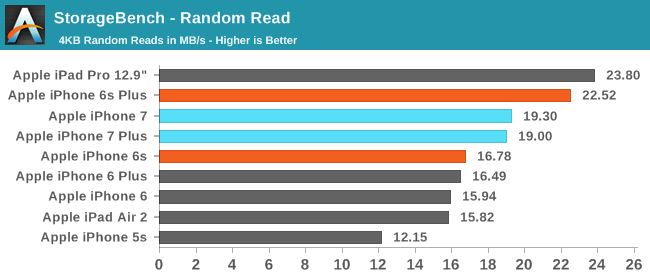
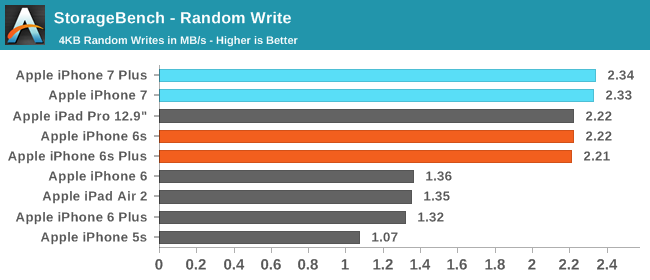

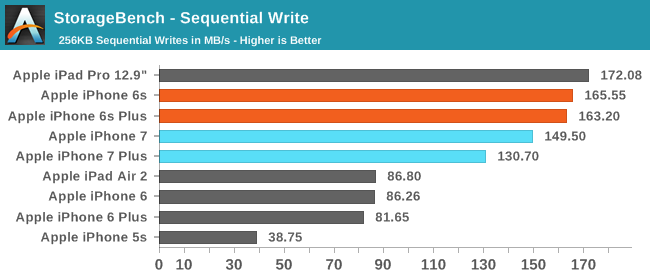
In general, the NAND performance of the iPhone 7 and 7 Plus is equivalent to the iPhone 6s and 6s Plus. There are some minor differences, but essentially all of them can be attributed to testing variance. The only thing that is worth noting is that there's no significant improvement to write performance even though the iPhone 7 units tested are 256GB models while the 6s and 6s Plus were 128GB models. This suggests that the NAND packages use higher capacity dies so there's no additional parallelism to take advantage of.










377 Comments
View All Comments
zodiacfml - Thursday, October 13, 2016 - link
Yep. The Google Pixel(s) is claimed to shoot HDR almost instantaneously which is useful to me. I don't use it if I will need flash photography on my Nexus 5. HDR is a must in most cases. White Balance is hard to fault after the HDR process.techconc - Thursday, October 13, 2016 - link
Well said. I suppose if people simply use their phones for texting, they wouldn't understand why more power is needed. I'm looking at what the iPhone 7 plus is doing with showing real time previews of fake bokeh on images in portrait mode. It's absolutely amazing what they are accomplishing on a phone these days.For that matter, try playing a game like World of Tanks Blitz on the Nexus 5X. Trust me, iPhone owners like users like them. It helps them pad their stats with more kills, etc. Honest, this "why do we need more performance" argument is pretty comical.
zodiacfml - Thursday, October 13, 2016 - link
You have a point there and I still use a Nexus 5 everyday. It is plenty fast 95% of the time and only lags during app updates which I don't mind. It is perfectly usable while doing its tasks of downloading and installing updates.I'm itching for new hardware though as the Nexus 5 could use an AMOLED display, larger battery, and external storage. A new SoC can help though with better battery life at idle or average tasks.
Yeah, I guess you are right about the 820. The 820 is impressive if found on devices around the price range of the One Plus 3. Androids with costs near an iPhone 7 is not good value.
omeryounos - Wednesday, October 12, 2016 - link
@Anadtech, really clever review. You guys totally omitted Galaxy S7 Edge (with Exynos 8890) from system performance & battery test to showcase Apple's greatest innovation ever. Especially your comments in Battery life section stating that look how much better it is from Galaxy S7 (Exynos) & omit any results from Galaxy S7 Edge (Exynos), knowingly that it will beat both iPhone 7 & Plus hands down in all battery test by hours. We (the readers) expect more balanced reviews from this site especially when it is coming weeks later than most mobile sites.BenSkywalker - Wednesday, October 12, 2016 - link
I'm curious why you didn't dive far more into Apple's utterly staggering breakthrough in LCD technology-"However, I think AMOLED's color shifting off angle puts it at a disadvantage"
Out of the hundreds of in depth instrumented tests I have witnessed and comparing hundreds of displays never have I seen a single LCD that was capable of besting *any* OLED in off angle performance- actually given the physics involved and how the displays are built, this is widely considered impossible. Given how extremely simple this is to test, I'm a bit confused as to why you haven't documented this industry changing technology and exactly what level of off angle performance improvement it shows over every other LCD ever made.
I saw the comments about off angle OLED colors being an issue in the laptop review posted a short while ago, figured you must have had a defective unit(the *only* explanation)- now you are saying this iPhone7 display bests all AMOLEDs at off angle color accuracy- really hoping you can post your measured results with exactly what degree of variation you are seeing.
Displaymate must have tested something wrong, they are still showing the iPhone7 with a catastrophic 55% drop off for brightness with some color shifting too at a mere thirty degrees, two of the photos on the front page of your review I think are also mislabeled, they say they are iPhone7 but they are showing abhorrent off angle viewing- they must be of some other, non Apple, phone.
JoshHo - Wednesday, October 12, 2016 - link
I think it goes without saying that LCD will have greater off-angle contrast reduction than AMOLED, but for color accuracy you can look at the dE2000 formula and see that changes in hue are more significant than changes in luminance in human perception of color. You can also see DisplayMate's results to see that the iPhone 7 has about a third of the color shift of the Note7's display with changes in viewing angle which is due in part to the subpixel arrangement:http://www.displaymate.com/iPhone7_ShootOut_1.htm
http://www.displaymate.com/Galaxy_Note7_ShootOut_1...
If you have any other questions or concerns please feel free to contact me by email as I don't have the time to sift through hundreds of comments searching for responses. My email is josh@anandtech.com.
philehidiot - Wednesday, October 12, 2016 - link
What I would like to see is a more in depth look at the sound quality. Not through the speakers but through headphones. The reason for this is that I attached a pair of monitoring headphones to my HTC M9 and found the top end to be incredibly harsh and distorted but when plugging those same headphones into my tablet (Kindle Fire 7 HDx) the sound was far better and there was no distortion. I would guess Apple would have better sound than the competition but a paragraph on wired headphone performance would be good and might well push more manufacturers to improve in this area. Interestingly, the Dolby "enhancements" make cheap headphones sound a load better but make decent monitoring headphones sound far worse - I assume this is because the compression applied to bring the sound into the limited dynamic range of the cheaper headphones actually helps but on the more expensive ones which can reproduce the full dynamic range of the recording it just effectively narrows it. Someone please correct me if I'm talking bollocks.UtilityMax - Wednesday, October 12, 2016 - link
For me, the iPhones do not exist, because I own a large media collection and I can't upload any of it to the iPhone without going through slow and buggy iTunes. On top of that, the iPhones do not exist for me after the 7 release after they deleted headphone jack. I own several audiophile grade but still very affordable headphone, and not of them can be used with it. I'd have to replace each one of them with a different set that costs something 2-3 times more and the benefits of doing that are pretty much dubious.So yes, in my world view, I would take a Moto G over the iPhone any day.
blackcrayon - Wednesday, October 12, 2016 - link
Sounds like you don't understand iPhones or iOS if you think you *HAVE* to use iTunes to put media on it... Hell, you don't even seem to know that they come with a headphone jack adapter for all of your "audiophile grade" headphones...UtilityMax - Wednesday, October 12, 2016 - link
I understand the iOS and issues very well. There are ways to bypass iTunes, then they still suck big time. As for the headphone jack, you can keep the headphone adapter to yourself. I am not carrying it, when it is about million times more convenient not to have to use it.